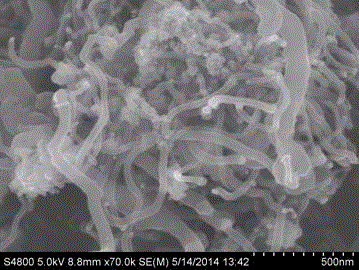A method for preparing carbon nanofibers by hydrogenation of carbon dioxide
A carbon nanofiber, carbon dioxide technology, applied in nanotechnology, nanocarbon, nanotechnology and other directions for materials and surface science, can solve the problems of high reaction energy consumption, high reaction conditions, complex reaction steps, etc. Easy to use, high catalytic efficiency
- Summary
- Abstract
- Description
- Claims
- Application Information
AI Technical Summary
Problems solved by technology
Method used
Image
Examples
preparation example Construction
[0019] Co-CeO 2 Catalyst preparation
[0020] Prepared by co-precipitation method, after cobalt nitrate solution and cerium nitrate solution are mixed uniformly, sodium hydroxide and sodium carbonate are used as precipitating agents, and the molar ratio of sodium hydroxide and sodium carbonate to sodium hydroxide and sodium carbonate is 1:1, and Flow titration, in this process, the pH value of the precipitation solution is controlled within the range of 10±0.1, stirred at room temperature for 4-5h, aged overnight, then filtered, washed repeatedly with distilled water until pH2 catalyst.
[0021] Co-CeO with a mass percentage of Co of 10% 2 Catalyst is taken as an example, prepared by co-precipitation method, the specific steps are as follows:
[0022] Weigh 0.988 Co(NO 3 ) 2 ·6H 2 O and 4.540g of Ce(NO 3 ) 3 ·6H 2 O, added to 200ml of deionized water to make nitrate solution A; weigh 0.800g of NaOH and 2.120g of NaOH with an electronic balance 2 CO 3 , was added to 2...
Embodiment 1
[0025] Using 60-100 mesh Co-CeO with a mass percentage of Co of 10% 2 The catalyst is used as a catalyst for carbon dioxide hydrogenation to prepare carbon nanofibers. Co-CeO 2 Catalyst and 60-100 mesh quartz sand are mixed evenly according to the weight ratio of 1:2, and the raw material gas is passed, and 1mgCo-CeO 2 Catalyst meter, feed gas ventilation rate is 2ml / min, feed gas composition is 50vol.%CO 2 , 50vol.%H 2 ; Catalyzed reaction at 450°C for 2h to obtain carbon nanofibers.
Embodiment 2
[0027] Using 60-100 mesh Co-CeO with a mass percentage of Co of 10% 2 The catalyst is used as a catalyst for carbon dioxide hydrogenation to prepare carbon nanofibers. Co-CeO 2 Catalyst and 60-100 mesh quartz sand are mixed evenly according to the weight ratio of 1:2, and the raw material gas is passed, and 1mgCo-CeO 2 Catalyst meter, feed gas ventilation rate is 2ml / min, feed gas composition is 50vol.%CO 2 , 50vol.%H 2 ; Catalyzed reaction at 500°C for 2h to obtain carbon nanofibers.
PUM
 Login to View More
Login to View More Abstract
Description
Claims
Application Information
 Login to View More
Login to View More - R&D
- Intellectual Property
- Life Sciences
- Materials
- Tech Scout
- Unparalleled Data Quality
- Higher Quality Content
- 60% Fewer Hallucinations
Browse by: Latest US Patents, China's latest patents, Technical Efficacy Thesaurus, Application Domain, Technology Topic, Popular Technical Reports.
© 2025 PatSnap. All rights reserved.Legal|Privacy policy|Modern Slavery Act Transparency Statement|Sitemap|About US| Contact US: help@patsnap.com

